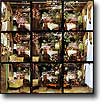Museo de Arte y Diseño Contemporáneo ,
Sep 06, 2006 - Oct 20, 2006
Antigua Fanal, San Jose, Costa Rica
Neither fickle chance nor precise laws
by Tamara Díaz Bringas
Time is also implicated in one of the most precise and poetic works selected: Sewing, by Karla Solano, in a few brief moments sews and tears the palm of a hand. To the lilt of a hummed lullaby, the video moves from the game to the wound, from tenderness to violence.
The works of Paulina Velasquez, the youngest artist to be awarded, refer to the infantile universe. Usando a John y Proceso (Using John and Process) attempt to communicate simple ideas by way of discreet gestures: a drawing, a doll-sculpture, a brief animation.
Priscilla Doesn’t Paint. Neither Do I
The current edition of the Biennial reveals a medium that is much more critical and complex, which in works like Neither do I, by Raphael Saenz (that makes reference to Priscilla no pinta, the first exhibition of Priscilla Monge, one of the Costa Rican artists with the most international recognition) is capable of revising the recent history of local art and of waxing ironic on the processes of legitimization on international circuits.
The reference to painting resonates also in Why Should I Paint?, an interrogation made by Ana de Vicente in her photographic work. Perhaps, the Biennial itself has some answers: out of 79 painters, only 7 were selected. Such a scant sampling nevertheless included very good exponents: Adrian Arguedas, Jose Alberto Arce and Fabricio Arrieta.
Sewing
Finally, I believe that in this edition, as never beforespectators were able to enjoy the selections as a more or less coherent exhibition, with relationships between works and between discourses. In the galleries of the Museum of Contemporary Art and Design, each work had adequate space and was in dialogue with its neighbors. It is no small achievement to produce a fluid exhibition having an open - and ample, complex and unequal – base of artists as a starting point.
The precise museography makes certain routes legible: the limits between reality and representation; a preoccupation with urban themes and with the political and social context; an indisposition toward the media and interpretation, be they made by the press, advertisments or the very police itself.
Without question, in the course of its five editions the Costa Rican Biennial has continued to establish itself as an important arena of exhibition and legitimization for local artists. However, it is also certain that its capacity for adjustment and openness will determine whether it grows, not merely into a sporadic thermometer of the local artistic scene, but into an indispensable space for confrontation and criticism.
|













